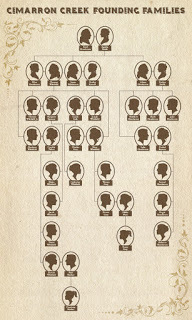Hints for Writing a Series
with guest, Amanda Cabot
How do you prepare to write a series? For me, there are six steps.
Step 1: Choose the Location
Realtors say, “location, location, location” and I agree. In fact, I consider the location to be the single most critical element in a book. Why? Although people’s motivations and problems are universal, where they live impacts them in many ways. Life on a farm is different from life in a small town, while someone who lives in a small town has different experiences from someone in a large city.
It’s not simply a question of farm vs. small town vs. big city. What’s equally important is where that farm, town, or city is located. A farm in the deep South will have different challenges from one on the Great Plains. Similarly, a town in the Texas Hill Country (which is where I’ve set many of my books) will be different from one in the Northeast.
Choose your location carefully. It should be one that appeals to you and one you know well. If you’re going to make the setting come alive for readers, you need to know what plants grow there, what birds roost in which trees, and what the air feels like.
Once you’ve decided where your story will take place, I highly recommend a map. If you’re using a real location, it’s easy enough to get a map of the town and/or the whole area. If you’ve created a fictional town, as I typically do, name the streets, highlight key landmarks, and decide who lives where. That’s what I did for Cimarron Creek.

Step 2: Choose the Specific Year
Like location, this is critical, since what’s happening in the world at that time will impact the storyline. My Cimarron Creek series takes place fifteen years after Appomattox, but even though it’s been more than a decade, the wounds inflicted by the War Between the States have yet to heal.
Step 3: Identify Your Main Characters and their Relationships
The next step is to determine who your protagonists and key secondary characters will be. If you’re a pantser rather than a plotter, you might be tempted to work on only one book at a time. The disadvantage to this approach is that it’s more difficult to integrate characters from one story into the next if you haven’t planned it in advance. And since one reason readers enjoy series is the continuing characters, it’s important to know how everyone fits into the picture.
 When I started the Cimarron Creek trilogy, I knew that the town’s two founding families would be key players and that their familial relationships would be important. That’s why I created a formal family tree. While this may or may not be needed for your books, if you have multiple generations of a single family involved, you may want to do something similar.
When I started the Cimarron Creek trilogy, I knew that the town’s two founding families would be key players and that their familial relationships would be important. That’s why I created a formal family tree. While this may or may not be needed for your books, if you have multiple generations of a single family involved, you may want to do something similar.
At this point, I also determine which characters will be newcomers. If you’ve read my books, you’ll notice that in almost every one either the hero or the heroine is new to the town. Why? Not only does “new blood” make a story more interesting, but having a stranger (or in the case of A Tender Hope three strangers) come to town changes the dynamics.
Step 4: Decide Whether or Not to Have an Overarching Plot Line
If you’re a fan of TV’s “Castle” or “Longmire,” you know how effective an overarching plot line can be. While viewers had the satisfaction of seeing a mystery resolved in each episode, they kept tuning in to learn who killed Kate’s mother and Longmire’s wife. I decided to try a similar approach with the Cimarron Creek books, having the central mystery be what happened to Aunt Bertha’s daughter. The storyline is introduced in A Stolen Heart, takes some unexpected turns in A Borrowed Dream, and isn’t fully resolved until A Tender Hope.
If you decide to take this approach, I caution you. On the surface, it seems easy enough to do, but the reality is that it’s more complex than you might expect, particularly if you’re like me and want to ensure that your books can be read as standalones.
Step 5: Identify the Internal and External Conflicts of Each Book
We all know that a successful book includes both internal and external conflicts for each of the key protagonists. When writing a series, it’s essential to ensure that those conflicts are different for each book. If not, readers will start yawning, saying “same old, same old,” and will be less likely to buy the next book.
Step 6: Leave the Door Open for More Stories
While it’s important to resolve all key plot points by the end of the series or risk readers being disappointed, it never hurts to introduce secondary characters who are interesting enough that readers will want to know what happens to them. Even if you have no plans for a follow-on series, you never can tell when those characters will demand their own story. That’s what happened with Thea. I introduced her in Paper Roses ten years ago, and she captivated readers so much that now she’s the heroine of her own story.
I hope my six steps make sense to you and that they help you plan your own series. Speaking as both a reader and a writer, series are fun!
~~~~~~~
As far as Thea Michener is concerned, it’s time for a change. With her husband murdered and her much-anticipated baby stillborn, there is nothing left for her in Ladreville. Having accepted a position as Cimarron Creek’s midwife, she has no intention of remarrying. So when a handsome Texas Ranger appears on her doorstep with an abandoned baby, Thea isn’t sure her heart can take it.
Ranger Jackson Guthrie isn’t concerned only with the baby’s welfare. He’s been looking for Thea, convinced that her late husband was part of the gang that killed his brother. But it soon becomes clear that the situation is far more complicated than he anticipated—and he’ll need Thea’s help if he’s ever to find the justice he seeks.
 Amanda Cabot’s dream of selling a book before her thirtieth birthday came true, and she’s now the author of more than thirty-five novels as well as eight novellas, four non-fiction books, and what she describes as enough technical articles to cure insomnia in a medium-sized city. Her inspirational romances have appeared on the CBA and ECPA bestseller lists, have garnered a starred review from Publishers Weekly, and have been nominated for the ACFW Carol, the HOLT Medallion, and the Booksellers Best awards. A popular workshop presenter, Amanda takes pleasure in helping other writers achieve their dreams of publication.
Amanda Cabot’s dream of selling a book before her thirtieth birthday came true, and she’s now the author of more than thirty-five novels as well as eight novellas, four non-fiction books, and what she describes as enough technical articles to cure insomnia in a medium-sized city. Her inspirational romances have appeared on the CBA and ECPA bestseller lists, have garnered a starred review from Publishers Weekly, and have been nominated for the ACFW Carol, the HOLT Medallion, and the Booksellers Best awards. A popular workshop presenter, Amanda takes pleasure in helping other writers achieve their dreams of publication.
Social Media Linkswww.amandacabot.comhttps://www.facebook.com/amanda.j.cabothttps://twitter.com/AmandaJoyCabot/http://amandajoycabot.blogspot.com/
Buying Links Amazon Barnes & Noble Christian Book Distributors
How do you prepare to write a series? For me, there are six steps.
Step 1: Choose the Location
Realtors say, “location, location, location” and I agree. In fact, I consider the location to be the single most critical element in a book. Why? Although people’s motivations and problems are universal, where they live impacts them in many ways. Life on a farm is different from life in a small town, while someone who lives in a small town has different experiences from someone in a large city.
It’s not simply a question of farm vs. small town vs. big city. What’s equally important is where that farm, town, or city is located. A farm in the deep South will have different challenges from one on the Great Plains. Similarly, a town in the Texas Hill Country (which is where I’ve set many of my books) will be different from one in the Northeast.
Choose your location carefully. It should be one that appeals to you and one you know well. If you’re going to make the setting come alive for readers, you need to know what plants grow there, what birds roost in which trees, and what the air feels like.
Once you’ve decided where your story will take place, I highly recommend a map. If you’re using a real location, it’s easy enough to get a map of the town and/or the whole area. If you’ve created a fictional town, as I typically do, name the streets, highlight key landmarks, and decide who lives where. That’s what I did for Cimarron Creek.

Step 2: Choose the Specific Year
Like location, this is critical, since what’s happening in the world at that time will impact the storyline. My Cimarron Creek series takes place fifteen years after Appomattox, but even though it’s been more than a decade, the wounds inflicted by the War Between the States have yet to heal.
Step 3: Identify Your Main Characters and their Relationships
The next step is to determine who your protagonists and key secondary characters will be. If you’re a pantser rather than a plotter, you might be tempted to work on only one book at a time. The disadvantage to this approach is that it’s more difficult to integrate characters from one story into the next if you haven’t planned it in advance. And since one reason readers enjoy series is the continuing characters, it’s important to know how everyone fits into the picture.
 When I started the Cimarron Creek trilogy, I knew that the town’s two founding families would be key players and that their familial relationships would be important. That’s why I created a formal family tree. While this may or may not be needed for your books, if you have multiple generations of a single family involved, you may want to do something similar.
When I started the Cimarron Creek trilogy, I knew that the town’s two founding families would be key players and that their familial relationships would be important. That’s why I created a formal family tree. While this may or may not be needed for your books, if you have multiple generations of a single family involved, you may want to do something similar.At this point, I also determine which characters will be newcomers. If you’ve read my books, you’ll notice that in almost every one either the hero or the heroine is new to the town. Why? Not only does “new blood” make a story more interesting, but having a stranger (or in the case of A Tender Hope three strangers) come to town changes the dynamics.
Step 4: Decide Whether or Not to Have an Overarching Plot Line
If you’re a fan of TV’s “Castle” or “Longmire,” you know how effective an overarching plot line can be. While viewers had the satisfaction of seeing a mystery resolved in each episode, they kept tuning in to learn who killed Kate’s mother and Longmire’s wife. I decided to try a similar approach with the Cimarron Creek books, having the central mystery be what happened to Aunt Bertha’s daughter. The storyline is introduced in A Stolen Heart, takes some unexpected turns in A Borrowed Dream, and isn’t fully resolved until A Tender Hope.
If you decide to take this approach, I caution you. On the surface, it seems easy enough to do, but the reality is that it’s more complex than you might expect, particularly if you’re like me and want to ensure that your books can be read as standalones.
Step 5: Identify the Internal and External Conflicts of Each Book
We all know that a successful book includes both internal and external conflicts for each of the key protagonists. When writing a series, it’s essential to ensure that those conflicts are different for each book. If not, readers will start yawning, saying “same old, same old,” and will be less likely to buy the next book.
Step 6: Leave the Door Open for More Stories
While it’s important to resolve all key plot points by the end of the series or risk readers being disappointed, it never hurts to introduce secondary characters who are interesting enough that readers will want to know what happens to them. Even if you have no plans for a follow-on series, you never can tell when those characters will demand their own story. That’s what happened with Thea. I introduced her in Paper Roses ten years ago, and she captivated readers so much that now she’s the heroine of her own story.
I hope my six steps make sense to you and that they help you plan your own series. Speaking as both a reader and a writer, series are fun!
~~~~~~~

As far as Thea Michener is concerned, it’s time for a change. With her husband murdered and her much-anticipated baby stillborn, there is nothing left for her in Ladreville. Having accepted a position as Cimarron Creek’s midwife, she has no intention of remarrying. So when a handsome Texas Ranger appears on her doorstep with an abandoned baby, Thea isn’t sure her heart can take it.
Ranger Jackson Guthrie isn’t concerned only with the baby’s welfare. He’s been looking for Thea, convinced that her late husband was part of the gang that killed his brother. But it soon becomes clear that the situation is far more complicated than he anticipated—and he’ll need Thea’s help if he’s ever to find the justice he seeks.
 Amanda Cabot’s dream of selling a book before her thirtieth birthday came true, and she’s now the author of more than thirty-five novels as well as eight novellas, four non-fiction books, and what she describes as enough technical articles to cure insomnia in a medium-sized city. Her inspirational romances have appeared on the CBA and ECPA bestseller lists, have garnered a starred review from Publishers Weekly, and have been nominated for the ACFW Carol, the HOLT Medallion, and the Booksellers Best awards. A popular workshop presenter, Amanda takes pleasure in helping other writers achieve their dreams of publication.
Amanda Cabot’s dream of selling a book before her thirtieth birthday came true, and she’s now the author of more than thirty-five novels as well as eight novellas, four non-fiction books, and what she describes as enough technical articles to cure insomnia in a medium-sized city. Her inspirational romances have appeared on the CBA and ECPA bestseller lists, have garnered a starred review from Publishers Weekly, and have been nominated for the ACFW Carol, the HOLT Medallion, and the Booksellers Best awards. A popular workshop presenter, Amanda takes pleasure in helping other writers achieve their dreams of publication.Social Media Linkswww.amandacabot.comhttps://www.facebook.com/amanda.j.cabothttps://twitter.com/AmandaJoyCabot/http://amandajoycabot.blogspot.com/
Buying Links Amazon Barnes & Noble Christian Book Distributors
Published on February 28, 2019 21:00
No comments have been added yet.



